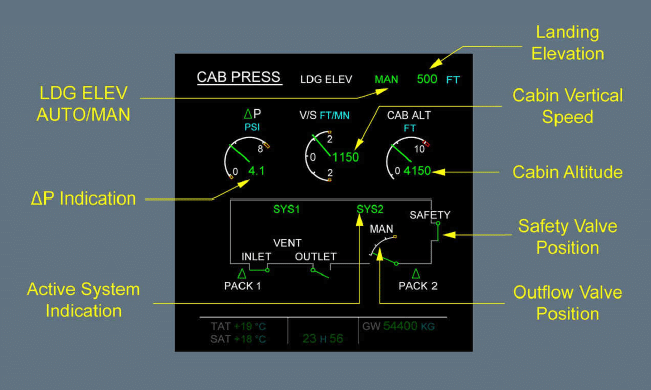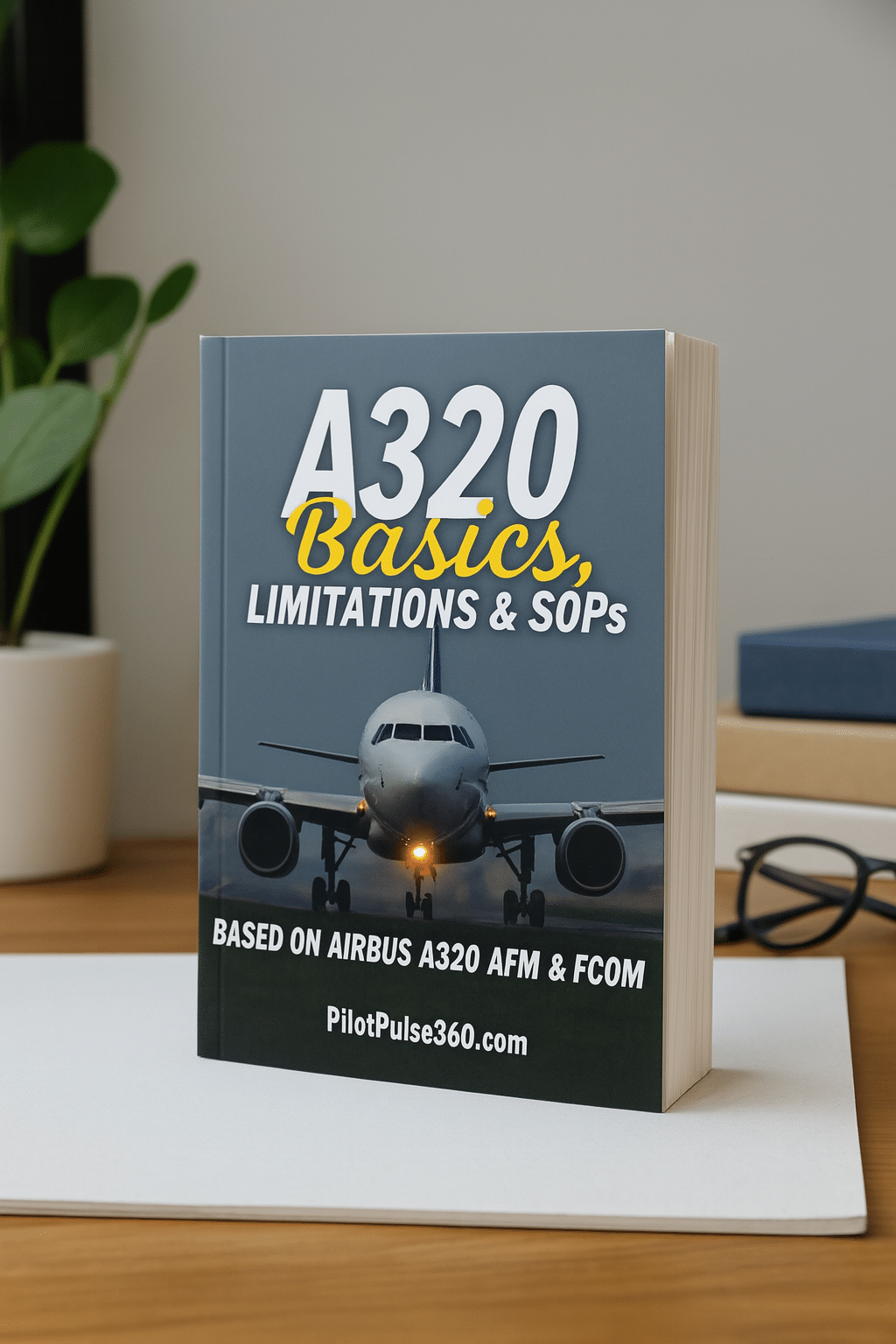Airbus A320, Pressurization System
Airbus A320 Pressurization System Explained – Cabin Altitude & Safety Logic
Why Pressurization Matters
In modern airliners like the Airbus A320, maintaining a safe and comfortable cabin environment is essential at cruise altitudes above 30,000 ft. At these heights, ambient pressure and oxygen levels are far too low for passengers and crew.
The A320 pressurization system automatically controls the cabin altitude, rate of change, and differential pressure using bleed air from the engines or APU.
According to the Airbus A320 FCOM, the system is fully automatic, with manual backup available through the Cabin Pressure Control Panel (CPCP) located on the overhead panel.
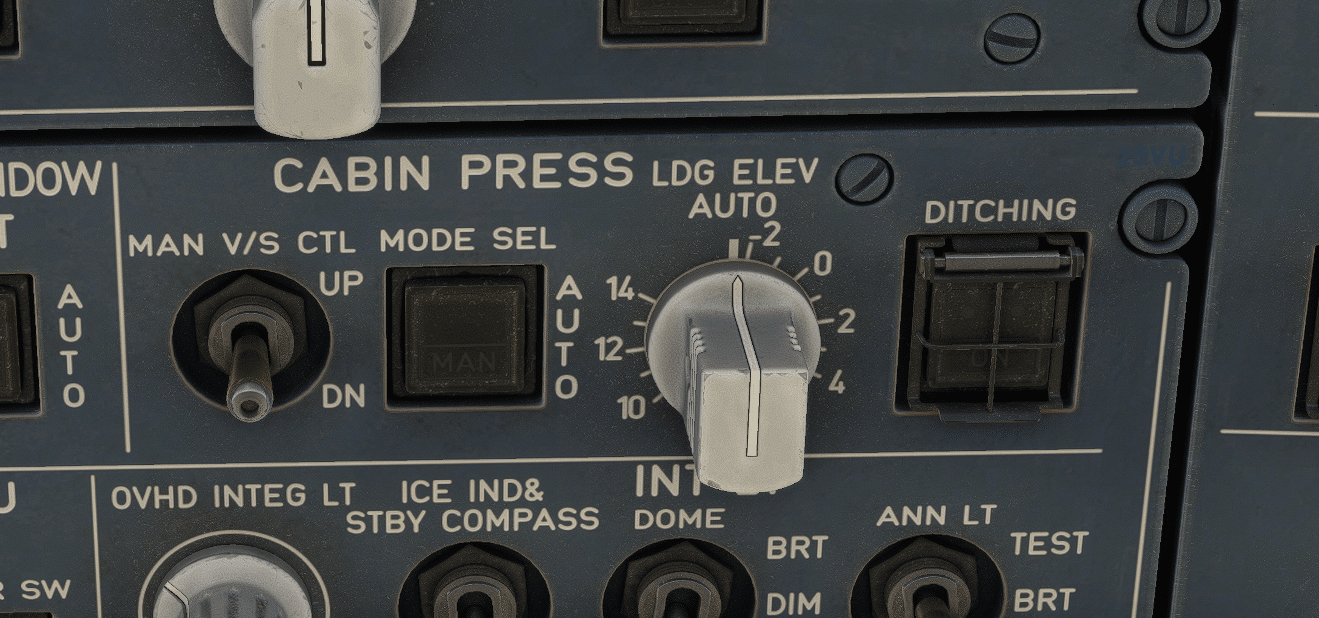
A320 System Overview
The A320 uses two independent Cabin Pressure Controllers (CPCs), each capable of controlling pressurization automatically.
Only one CPC is active at a time; the other remains in standby and takes over automatically in case of failure.
A320 Basics, Limitations & SOPs
Complete A320 study guide by an Airbus pilot & instructor.Clear systems, logic & SOPs.
PDF • 365 pages • Lifetime updates
The pressurization system primarily consists of:
- Two CPCs – manage cabin pressure automatically.
- One Outflow Valve – regulates air leaving the fuselage.
- Two Safety Valves – prevent overpressure or negative pressure differentials.
- Cabin Pressure Control Panel (CPCP) – allows AUTO or MANUAL operation.
- ECAM indications – provide real-time feedback on cabin altitude, rate, and differential pressure.
As stated in the A320 AFM, the system maintains a cabin altitude below 8,000 ft up to the aircraft’s maximum certified altitude of 39,800 ft.
Air Supply and Cabin Pressure Regulation
Bleed air from the engines or the APU is routed through the air conditioning packs before entering the cabin.
Air exits via the outflow valve, which modulates continuously to maintain the desired pressure differential.
The Cabin Pressure Controller computes:
- Target cabin altitude
- Cabin rate of climb or descent
- Differential pressure
These are based on the aircraft’s flight phase, using data from the Air Data/Inertial Reference System (ADIRS) and Flight Management System (FMS).
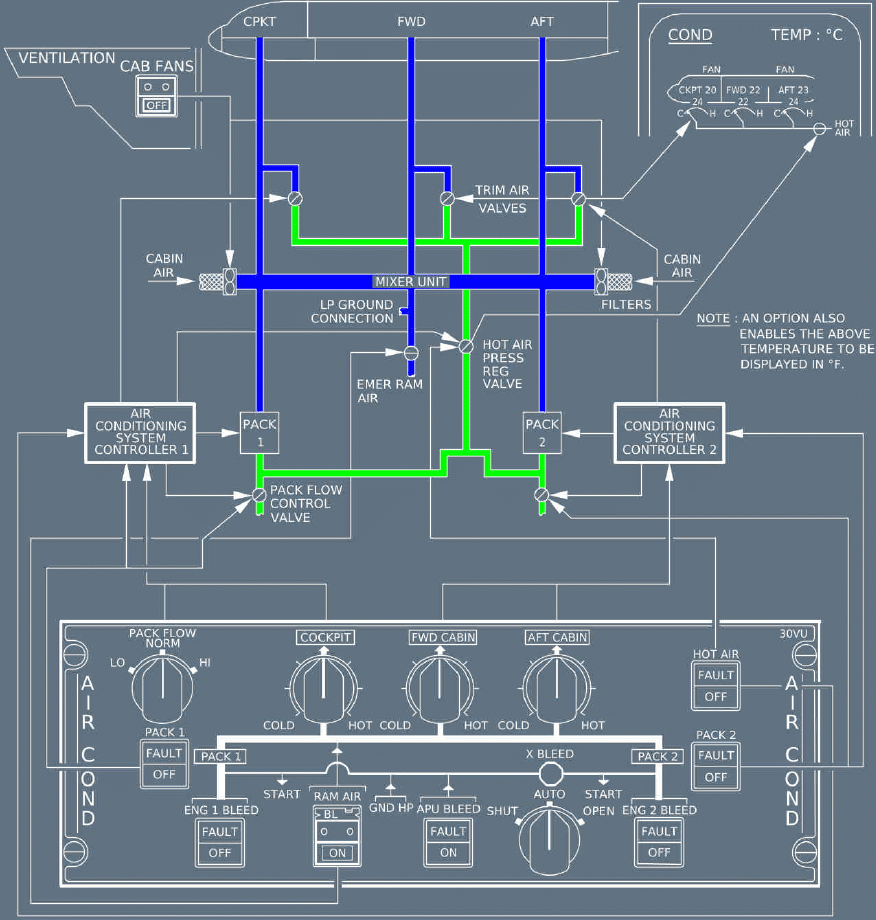
Modes of Operation
The A320 pressurization system operates in three pressurization modes, as detailed in the Airbus A320 FCOM and FCTM:
1. Automatic Mode (AUTO)
- Normally used throughout flight.
- The active CPC automatically schedules cabin altitude and differential pressure according to flight profile.
- Automatic swap between CPC 1 and CPC 2 occurs after each flight.
- If the active CPC fails, the standby controller takes over seamlessly.
2. Semi-Automatic Mode
- The system uses the LDG ELEV knob to manually select the destination airport elevation.
- This setting allows for better control during operations to high-altitude airports (e.g., Cusco or La Paz).
3. Manual Mode (MAN)
- Activated via the MODE SEL switch on the overhead panel.
- The outflow valve is then controlled directly by the MAN V/S CTL toggle switch.
- Cabin pressure rate and altitude must be adjusted manually, guided by ECAM indications.
Manual mode serves as a fail-safe backup and is described in the A320 FCOM DSC-21-20-40 “Controls and Indicators” section.
Phases of Operation
The pressurization schedule follows the aircraft’s flight profile automatically:
Before Takeoff – Pre-Pressurization
To prevent a pressure bump at rotation, the cabin is slightly pressurized (~0.1 psi differential) before liftoff.
Climb Phase
Cabin altitude rises smoothly, usually at a rate of 300–500 ft/min, maintaining a comfortable environment.
Cruise Phase
Cabin altitude stabilizes around 7,000–8,000 ft when cruising at FL350–FL390. Differential pressure is maintained at approximately 7.8 psi, as defined in the AFM Section LIM-21 “Air Conditioning/Pressurization”.
Descent and Landing
Cabin altitude descends gradually to match landing field elevation. Automatic depressurization occurs after touchdown once the aircraft is on ground, confirmed by the squat switch signal.
Safety Logic and Protections
The A320 pressurization system includes multiple safety layers to protect the fuselage and occupants:
- Safety Valves: Two spring-loaded valves open automatically if differential pressure exceeds 8.6 psi or becomes negative (to avoid inward collapse).
- Cabin Pressure Controllers: Include logic to avoid rapid pressure changes, limiting cabin vertical speed to 750 ft/min (climb) or 500 ft/min (descent).
- Residual Pressure Control Unit (RPCU): Ensures complete depressurization on the ground by opening the outflow valve once engines shut down.
- Backup Indications: ECAM PRESS page shows CAB ALT, ΔP, and V/S; warnings include “CAB PR EXCESS CAB ALT” and “CAB PR SYS FAULT.”
These safeguards ensure that even in failure modes, cabin altitude remains within survivable limits.
Pilot Interface and ECAM Indications
Pilots monitor and control pressurization via:
- CAB PRESS panel on the overhead.
- ECAM PRESS page, displaying system parameters such as:
- Cabin altitude (CAB ALT)
- Rate of climb/descent (V/S)
- Differential pressure (ΔP)
- Outflow valve position
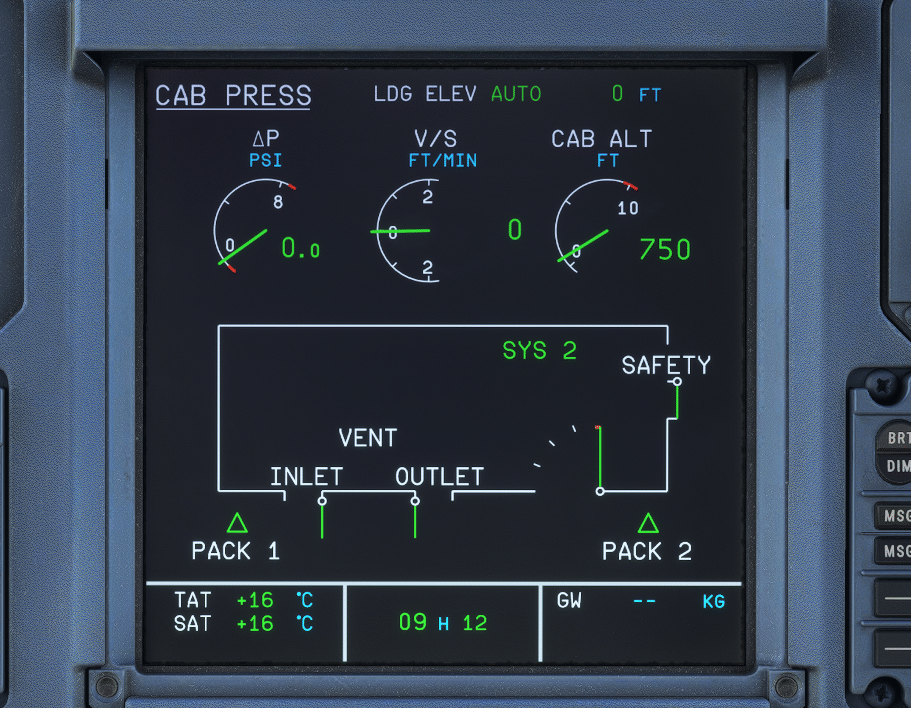
During automatic operation, ECAM automatically alerts the crew of any deviations, such as excessive cabin altitude or controller failure.
The A320 FCTM highlights that correct interpretation of ECAM indications is vital for timely manual intervention if required.
Failure and Manual Operation Procedures
In case of automatic system failure, pilots select MAN mode and use the MAN V/S CTL switch to modulate cabin rate. The FCTM advises small, progressive adjustments—never exceeding 500 ft/min—to avoid passenger discomfort.
If both CPCs fail, the outflow valve can still be positioned manually, allowing safe descent and landing with controlled cabin altitude.
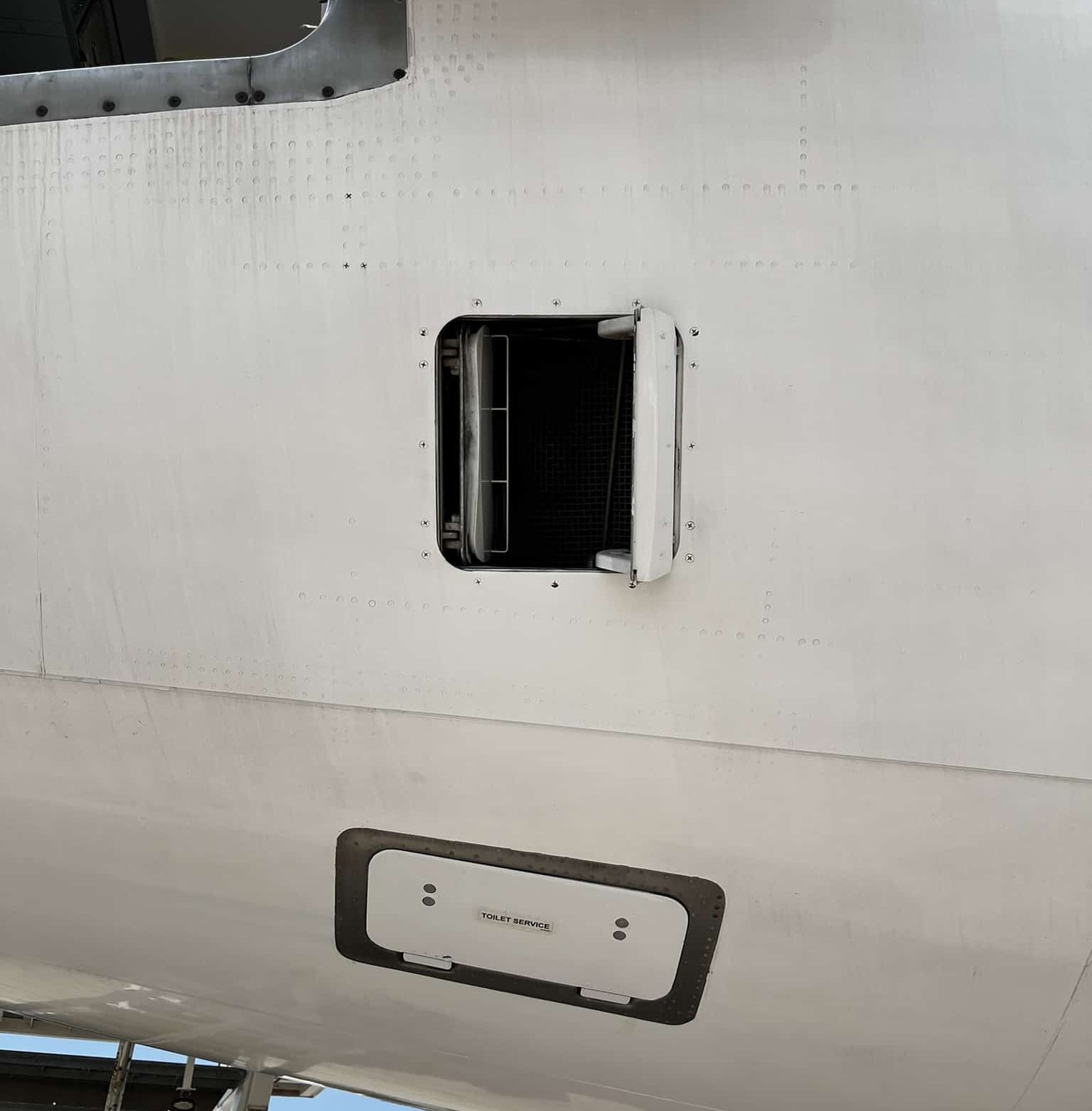
Operational Insight
From a flight deck perspective, the system’s automation drastically reduces pilot workload. During a typical flight:
- The cabin starts pressurizing as thrust is applied.
- Cabin altitude climbs slowly to maintain comfort.
- On descent, the system automatically depressurizes, aligning cabin and ambient pressures at touchdown.
This seamless cycle is why, under normal conditions, crews rarely intervene — the system operates quietly in the background, ensuring every A320 flight remains comfortable and safe.
The A320 pressurization system is a critical component of modern aviation, designed to maintain cabin air pressure at optimal levels during flight. Utilizing advanced pressurization control mechanisms, it effectively manages the outflow valve to ensure a consistent air pressure differential.
The system incorporates flow control valves that regulate the inflow and outflow of air, while the emergency ram air inlet provides an alternative in case of system failure.
By maintaining approximately 1 psi above ambient pressure, the A320 ensures passenger comfort and safety, while avionics ventilation is seamlessly integrated to support electronic systems during various flight phases.
Conclusion
The Airbus A320 cabin pressurization system is a fully automatic design that maintains passenger comfort and aircraft safety throughout all phases of flight.
The system consists of two Cabin Pressure Controllers that alternate control each flight to ensure redundancy. Each controller regulates the outflow valve by means of continuous adjustments that either increase or decrease pressure to avoid a surge in cabin conditions.
Cabin Pressurization Panel
The cabin pressurization panel on the overhead allows the flight crew to monitor and manually intervene if needed—its switch on the control panel can select manual mode so the crew can close the outflow valve or command it open.
During takeoff, the system slightly pressurizes the cabin to prevent a surge in cabin pressure at rotation, controlling cabin pressure during rotation and stabilizing climb rates.
Bleed Air
Bleed air from the air conditioning system and ventilation system supplies the cabin, with pack flow control valves regulating incoming air.
The system ensures smooth airflow through the avionics ventilation inlet and extract valves and controls the outflow of outside air via the main valve.
When in automatic pressurization mode, the CPCs maintain a steady cabin vertical speed of 500 ft/min during descent to avoid discomfort.
If a cabin overpressure before the ground occurs, the safety function fully opens the outflow valve to protect the fuselage, while the residual pressure on ground logic automatically depressurizes the aircraft.
Once parked, the remaining cabin pressure is released at a cabin vertical speed that prevents abrupt changes. The system ensures that any residual cabin pressure or remaining cabin air is vented safely.
During descent, the controllers adjust flow so that cabin altitude from climbing too rapidly is prevented, and the system smoothly increases cabin pressure to avoid sudden shifts.
When commanded manually, the panel allows the flight crew to operate the valve directly—one toggle operates the outflow valve slowly, while another can function fully opens the outflow valve to ensure quick depressurization if needed.
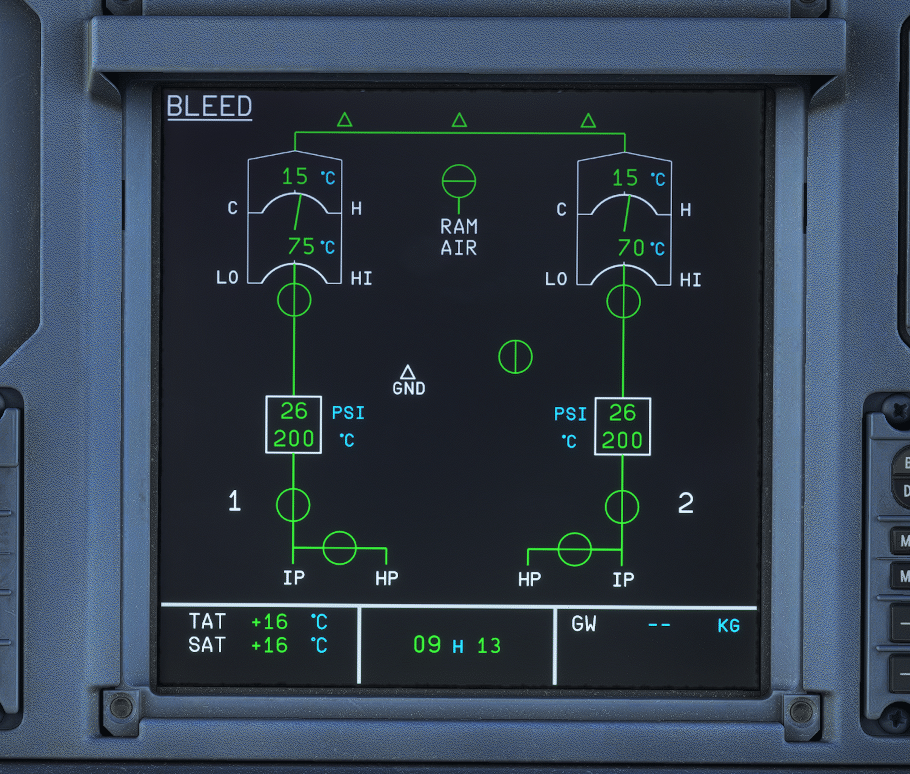
Control of Pressurization
The entire control of pressurization is automatic under normal conditions, but the system’s design guarantees redundancy, gradual cabin transitions, and full manual authority through the pressurization control panel whenever required.
Understanding how the system schedules cabin altitude and manages failures helps flight crew interpret ECAM messages accurately and respond effectively when manual control is required.
According to the Airbus A320 FCOM and AFM, the system maintains cabin altitude within safe limits throughout all flight phases, offering one of the most reliable cabin pressurization systems in its class.
Frequently Asked Questions – A320 Pressurization System
What does the A320 pressurization system do?
The A320 pressurization system automatically manages cabin altitude, rate of change, and differential pressure. It uses bleed air from the engines or APU, regulating it via two cabin pressure controllers and the outflow valve to maintain a safe, comfortable cabin environment throughout the flight.
How many cabin pressure controllers (CPCs) does the A320 use?
The Airbus A320 uses two Cabin Pressure Controllers (CPCs). One operates in automatic mode while the other stays in standby. The system switches control between them automatically each flight to ensure reliability and redundancy.
Why is the cabin pre-pressurized before take-off on the A320?
The system slightly pressurizes the cabin before take-off to prevent a pressure bump or surge during rotation. This pre-pressurization keeps the cabin pressure stable and comfortable as the aircraft begins to climb.
What are the operating modes of the A320’s pressurization system?
The system has three operating modes: Automatic (normal mode), Semi-Automatic (manual setting of landing elevation), and Manual (direct crew control of the outflow valve using the cabin pressurization panel).
How is cabin altitude managed during cruise?
During cruise, the A320 maintains cabin altitude around 7,000–8,000 ft, even when flying at 35,000 ft or higher. The active CPC automatically adjusts the outflow valve and bleed air flow through the air conditioning and ventilation systems to stabilize cabin conditions.
What safety protections does the system include?
The A320 pressurization system includes safety valves to prevent overpressure or negative pressure, a residual pressure control unit for ground depressurization, and logic to limit cabin vertical speed to around 500 ft/min to protect passengers and structure.
What happens after landing?
Once on the ground, the A320 automatically depressurizes. The outflow valve fully opens, releasing any remaining cabin pressure to ensure the aircraft is safe for ground operations and passenger disembarkation.
What happens if both CPCs fail?
If both controllers fail, the crew can switch to manual mode and control cabin pressure directly using the MAN V/S CTL switch on the cabin pressurization panel, allowing safe descent and landing.
Why is the outflow valve important and how does it operate?
The outflow valve regulates how much air leaves the cabin, maintaining the desired pressure. It operates automatically in small increments but can be manually opened or closed using the control panel if required.
What is “cabin vertical speed” and why is it important?
Cabin vertical speed measures how quickly cabin altitude changes. The A320 system limits this to approximately 500 ft/min to avoid discomfort or pressure surges for passengers and crew.

